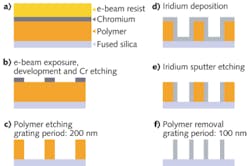Fraunhofer ILT shows new femtosecond amplifier concept

Aachen, Germany--Researchers at the Fraunhofer Institute for Laser Technology (ILT) have developed an amplification concept for femtosecond lasers that achieves mean output power in the kilowatt range for the first time.
The very short pulses of ultrafast femtosecond lasers offer the promise of ultraprecise material processing, say the ILT researchers, but these lasers have yet to become established in industrial production. This situation could change if femtosecond lasers with higher mean output power become commercially available--they would enable higher throughput, lower maintenance costs and easier usability possible.
The amplifier design is based on Innoslab technology developed in-house by Fraunhofer ILT and characterized by a simple, robust and compact construction. According to the researchers they have extended the amplifier design by using Yb-doped YAG as the active medium, which enables the amplification of ultrashort pulses due to its large bandwidth.
Since ytterbium-doped crystals place great demands upon the pump beam source, the availability of brilliant pump diodes has made this step first possible, they say. The oscillator-amplifier system enables, in addition, more flexibility with respect to the repetition rate and the pulse duration, since to generate the initial pulse there is a variety of commercial ultrafast oscillators available based on fiber and solid-state lasers with about two watts of mean laser power.
Dr. Peter Rußbüldt, project leader at the Fraunhofer ILT, has cascaded two Innoslab amplifiers, and the amplifier chain produced a mean power of 1.1 kW at a peak pulse power of 80 MW and a pulse duration of 600 fs. The Aachen researchers have thus reached a new record.
The original purpose of the joint project with the Max Planck Institute for Quantum Optics, funded by the BMBF (the German Federal Ministry of Education and Research), was a scientific application: the generation of coherent EUV radiation.
During the project, researchers continued to develop the laser at the Fraunhofer ILT. "Thanks to this new power output, the femtosecond laser slowly departs from its image as a scientifically complicated toy," said Dr. Rußbüldt. "The higher power means the throughput also increases in production, which, in turn, means an enormous time and cost-based advantage for manufacturers. Therefore, the femtosecond laser can now be applied in fields in which its throughput did not suffice in the past," he said.
Typical applications of the femtosecond laser in the macro sector are manufacturing processes for fiber-composite lightweight components. A femtosecond laser can process the largest variety of materials irrespective of their characteristics. In the micro sector the applications of this new beam source range from drilling of nozzles to tool engineering, solar cell engineering all the way to printing technology.
The Fraunhofer ILT will hold a workshop on this topic on April 13 and 14, 2011 in Aachen. Experts from research and industry will provide information about the foundations and laser beam sources of ultrashort pulse lasers (USP) and discuss relevant applications for material processing jointly with participants. Technological developments and their market potential will be illuminated in this USP workshop.
At Photonics West in January, the Fraunhofer ILT researchers will present the new high-power lasers during a paper at the LASE conference there. Also during Photonics West, Dr. Reinhart Poprawe, director of the Fraunhofer Institute for Laser Technology will deliver the Keynote Address: "High-Power Diode Lasers: The ultimate source for economic photons in the next decade" at the Lasers & Photonics Marketplace Seminar.
Stephen G. Anderson | Director, Industry Development - SPIE
Stephen Anderson is a photonics industry expert with an international background and has been actively involved with lasers and photonics for more than 30 years. As Director, Industry Development at SPIE – The international society for optics and photonics – he is responsible for tracking the photonics industry markets and technology to help define long-term strategy, while also facilitating development of SPIE’s industry activities. Before joining SPIE, Anderson was Associate Publisher and Editor in Chief of Laser Focus World and chaired the Lasers & Photonics Marketplace Seminar. Anderson also co-founded the BioOptics World brand. Anderson holds a chemistry degree from the University of York and an Executive MBA from Golden Gate University.